Solar shades, as known as solar screen shades or UV block shades, these light filtering sun shades are specifically designed to block UV rays and to minimize glare while preserving your view outdoors.
They are made of woven screen type fabrics and are available in different levels of openness (1%-14%) which determine how much light they allow in a room. Solar roller shades do not afford the same level of privacy as blackout or room darkening shades, but they block UV rays and sunlight while still being able to enjoy the view out your windows.
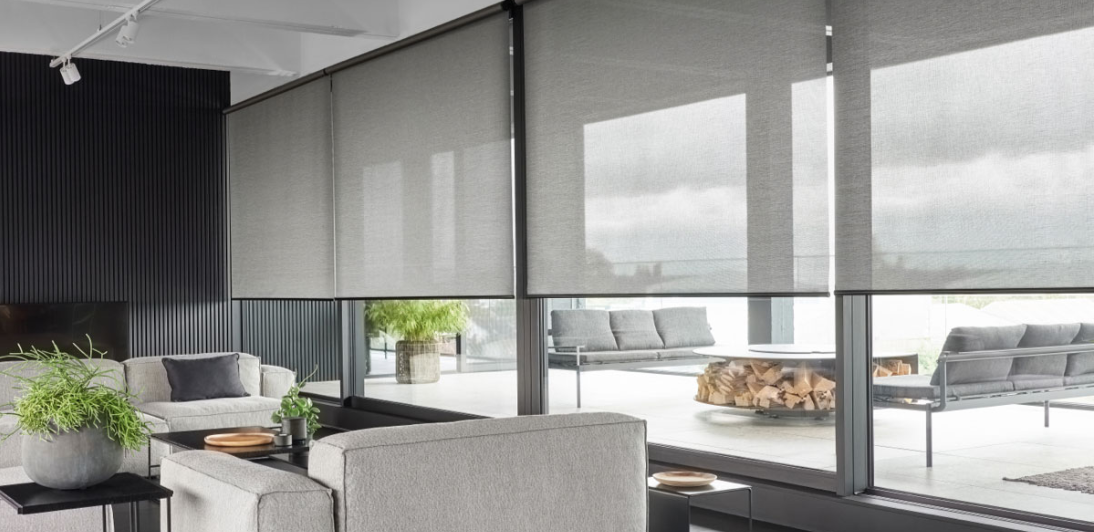
These sun screen shades are perfect for living rooms, offices, patios, and sun rooms where you want to protect furniture, eliminate glare and block UV rays. They are energy efficient, stylish and come in corded, wand crank or motorized versions for contemporary, functional window dressings.
Table of Contents
Do solar shades provide privacy
Do solar shades block heat
Are solar shades energy efficient
Are solar shades see through at night
Do solar shades block uv rays
Do solar shades keep cold out
Do solar shades keep heat out
What does openness mean for solar shades
What does 1 openness mean in solar shades
What does 5 openness mean in solar shades
Solar shades openness 3 vs 5
What is the difference between light filtering and solar shades
What is the difference between roller shades and solar shades
Difference between light filtering solar shades and room darkening blinds
Solar shades vs cellular shades
Solar screens vs window tint
How much do solar shades cost
How to install solar shades
What color solar shade works best
Do Solar Shades Provide Privacy?
Solar roller shades provide daytime privacy, which is to say people outside can’t see inside during the day. But at night, with indoor lights shining, they’re see-through blinds from the outside.
If privacy is desired after dark, solar screen shades are commonly used with room darkening curtains, dual roller shades or privacy liners. They Work: Use in daytime-use areas where an outside view and glare reduction, not nighttime privacy is important.
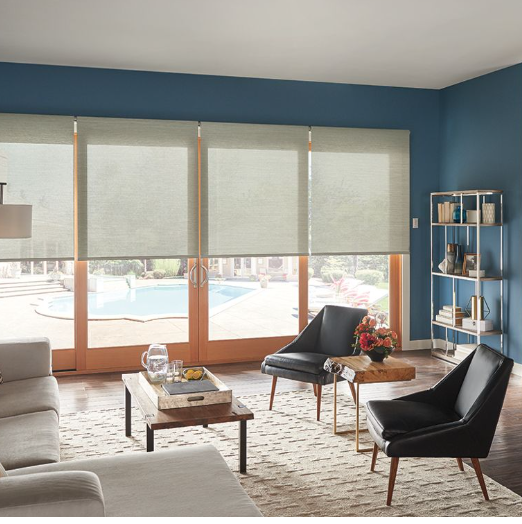
Do Solar Shades Block Heat?
Yes, solar screen shades are made to minimize heat gain with a combination of reflection and filtration.
As heat-blocking window shades, they’re especially effective when constructed of darker fabrics or with lower openness factors (1%–5%). By reducing the intensity of the sun via windows, they allow you to keep temperatures cooler inside the house and lower your dependence on air conditioning – ideal for hot climates and sun-exposed windows. They’re at their best when paired with insulated curtains or cellular shades for maximum performance.
Are Solar Sun Shades Energy Efficient?
Solar sun shades can be an excellent energy-efficient window coverings. By filtering out damaging UV rays and decreasing solar heat gain, they can help reduce summer cooling costs.
While they don’t insulate as effectively as cellular blinds, they make heating and cooling systems more efficient by minimizing temperature swings. High-efficiency solar shades can also be combined with thermal curtains or blackout liners for even more insulation and year-round energy savings.
Can You See Through Solar Shades at Night?
Solar blinds are see through at night? When it is dark outside and you have lights on inside, solar shades are almost transparent and provide little privacy.
They act as a kind of clear mesh blind, which is good for glare control during the daytime work-hours, but not ideal for bedrooms or bathrooms. If nightime privacy is at the top of your list, you may select dual-layer blinds, blackout shades, or curtain overlays for a comprehensive solution.
Do Solar Shades Block UV Rays?
Absolutely. UV protection shades such as solar blinds are designed to filter up to 99% of the sun’s harmful ultraviolet (UV) rays, varying depending of fabric openness.
This will help prevent floors, furniture and art work from fading. These light-filtering blinds filter in sunlight, and also filter in damaging UV rays — ideal for spaces with lots of windows or direct sunlight.
Do Solar Shades Keep Cold Out?
Although solar window treatments are great at blocking the sun and heat, they won’t have the same insulating effect when it’s cold out.
Solar sun shades are not like with thermal blinds or cellular shades because the materials are thin, and breathable mesh that do not capture air and has tiny holes to allow the circulation of air between the room and the outside world. Then for colder regions, it’s advisable to use them with thermal insulated draperies, layered curtains, or double roller systems that increase energy efficiency in the winter.
Do Solar Shades Block Heat?
Yes, you can reduce indoor heat by preventing solar radiation from penetrating the room using solar window coverings.
By reflecting sunlight and blocking U.V. rays, they could reduce interior temperatures by a few degrees, depending on the fabric and openness. Sun-blocking blinds are particularly effective in rooms that face south and west where the sun is hottest. To maximize your heat reduction, use solar shades in conjunction with motorized smart blinds or heat reflecting window films.
What Does Openness Mean for Solar Shades?
Openness in solar shades refers to the degree of which the fabric is woven with open space letting light and visibility to pass through.
A lower openness (such as 1% or 3%) will block more sunlight and provide more glare and UV protection and a higher openness (such as 10%) will allow more light and a clearer view outside. The right solar shade openness level all comes down to how much visibility, privacy and sun control you want. It’s a big reason why solar screen shades can perform differently in various rooms or orientations.
What Does 1 Openness Mean in Solar Shades?
A 1% openness solar shade indicates that the fabric is woven so tightly that only 1% of it is open.
It offers great UV protection (up to 99%), good glare control and excellent privacy during the day. It's perfect for rooms that receive direct sunlight, or for guarding sensitive interiors (such as hardwood floors and artwork), from the sun. While it darkens the view outside, it provides excellent solar performance. Frequently found in offices, media rooms or sun-drenched living areas as a performance UV Blocking window dressing.
What Does 5 Openness Mean in Solar Shades?
5% openness solar shades are middle of the road, giving a lot of view and light control. Featuring 5% openness fabric, they block the sun while offering moderate visibility and airflow.
They are often used in living rooms, kitchens and patios to help maintain views and natural light. They block about 95% of UV rays, so are a good option for you if you are looking for an all-purpose sun protection without totally blacking out the room. These are 5% openness, out to medium openness in solar blinds which are adequate for east, or north windows.
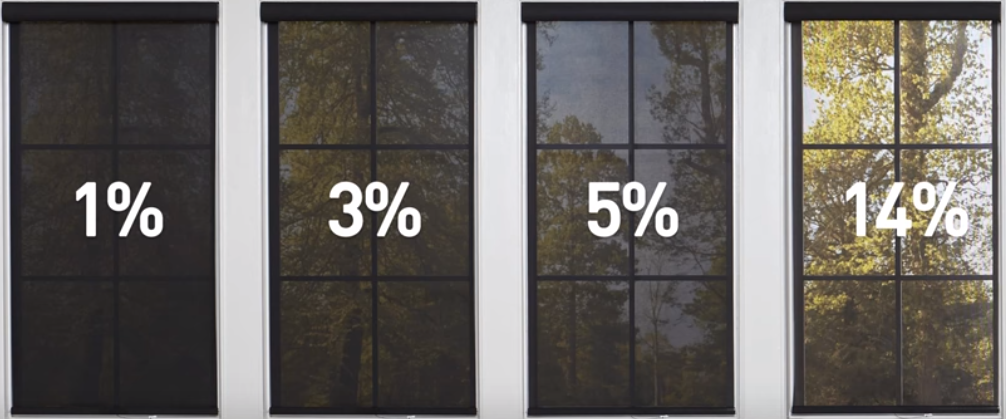
Solar Shades Openness 3 vs 5
3% vs 5% openness solar shades is a balance of view and protection.
A 3% shade shatters even more sunlight, glare, and UV rays (up to 97%), but sacrifices a tad bit more visibility vs. a 5%. On the flip side, 5% means a clearer view and more light, less heat and UV only a tad. Both are popular in living spaces, but 3% is more suitable for sun-drenched rooms, and 5% is a good choice for moderately lit spaces. The choice depends on what matters to you: a view or some level of protection.
What Is the Difference Between Light Filtering and Solar Shades?
Both kinds of window shades (whether they are light filtering or solar) are in place to soften the sunlight, but that is where the similarities end.
Light filtering shades such as woven polyester or fabric blinds shield light to give an ambiance of a warm glow and some privacy, create an ideal room for bedrooms, living room and dining room.
Solar shades are made of mesh fabric or other sheer material that is used to block UV rays, reduce glare, and still allows you to look outside. They are most effective for sun-facing windows, or conditions where viewing a screen is still necessary. Light filtering is about ambiance, and solar screen shades are performance and UV control.
What Is the Difference Between Roller Shades and Solar Shades?
Roller shades is a collective term of solar shades, blackout shades and light filtering shades.
Solar roller shades are a type of roller shade constructed using UV-blocking mesh to lessen heat and glare. Roller shades are available in opaque or sheer, depending on fabric. While both options utilize the same type of rolling mechanism, what they do is different — roller shades block light and offer blackout and privacy, roll up and down solar sun shades control sun and provide daytime privacy while maintaining your outside view. In other words: a solar shade is a type of roller shade, but not all roller shades are solar.
Difference Between Light Filtering Solar Shades and Room Darkening Blinds
Light filtering solar sun shades let in the light and reduce glare though not intended for privacy; insulate your home by reducing summer heat gain and winter heat loss while maintaining your view of the outside; they also block harmful UV rays.
Room darkening blinds, they are made to darken the room, meaning they block much more light — it’s not 100% blackout shade, but more than regular window shades do. They’re also typically of heavier fabrics or layered construction. Light filtering solar shades work well for daytime living areas, while room darkening window treatments are ideal for bedrooms or media rooms that need total light control.
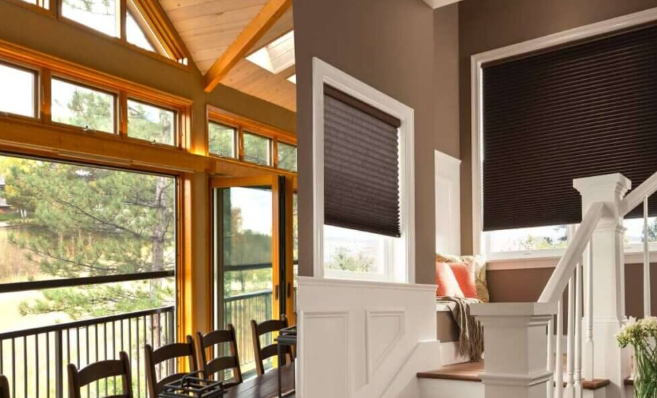
Solar Shades vs Cellular Shades
Solar patio shades are crafted from an open-weave fabric that helps block glare and harmful UV rays, while maintaining a view to the outside—ideal for sun control.
Cellular shade (honeycomb shade) creates a solid barrier that blocks drafts on windows offering protection from the cold and drafts.
Solar shades are great for rooms that have a lot of sun, but require some visibility, but cellular shades provide better insulation and privacy. Opt for solar for UV-blocking and an outside view; go with cellular for thermal properties and room darkening.
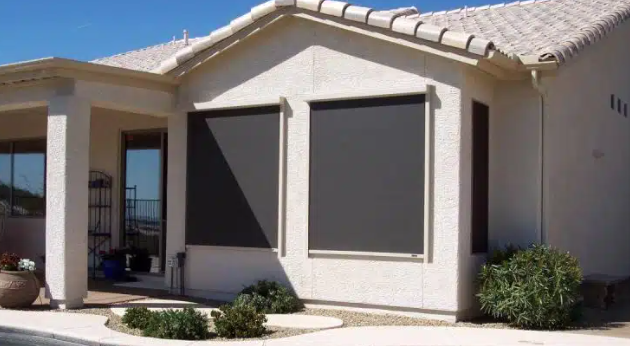
Solar Screens vs Window Tint
The benefits of solar screens are that they are external or internal sun shades that are constructed from a type of fabric (denser than an insect screen, yet lighter than a canvas tarp) called mesh so that they reduce the amount of ultraviolet light, heat and glare from coming through the openings of your screen.
Tint is a film that is installed on the glass, to provide tempered light and some heat reduction.
Solar screens are more versatile — you can raise and lower them — and cheaper and easier to replace or upgrade. Tints are permanent, and though there can be seal damage in dual pane windows. Opt for solar screen shades for flexibility, or window film for low-profile UV protection.
How Much Do Solar Shades Cost?
Solar shades typically run from $60 up to $300 per window, according to fabric openness, size, brand and motorization.
Standard solar roller shades can be cheaper, while custom or motorized can be more expensive. Top-shelf choices are those with 1% openness, dual roller systems or smart home integration. While pricier than standard roller shades, these feature good energy savings, glare control, and UV protection along with the convenience of automation.
How to Install Solar Shades
Installing solar shades is straightforward. For this, you will need a drill, screws, brackets, level and measuring tape.
The shades can be installed in the window frame for a polished look or outside for better coverage.
After the bracket locations are marked, drill pilot holes and secure the brackets by snapping the roller or screwing it in. The majority of DIY solar shades come with very clear instructions. Double-check your shade size before drilling if you want your life to be a little less like a sitcom.
What Color Solar Shade Works Best?
The performance and appearance are related with shade of solar shade.
Deeper colors (black, charcoal, dark brown) are effective at blocking glare and providing a crisper view outside. Lighter shades (white, beige, gray) will reflect more heat and light and and also help keep the interior cooler, but they can limit visibility from the outside. Dark shades work best in west- or south-facing windows. To reflect the most sun and keep spaces cool, choose light hues.
One popular option is dual roller shades: a light solar shade to filter the sunlight during the day and a second blackout layer to block out the light at night.

 English
English


















